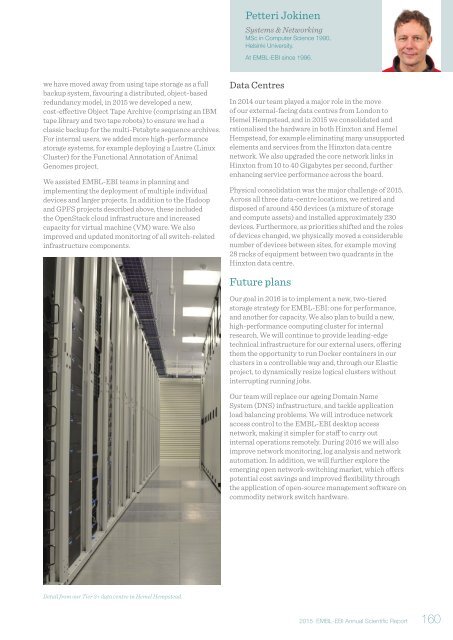Annual Scientific Report 2015
EMBL_EBI_ASR_2015_DigitalEdition
EMBL_EBI_ASR_2015_DigitalEdition
Create successful ePaper yourself
Turn your PDF publications into a flip-book with our unique Google optimized e-Paper software.
Petteri Jokinen<br />
Systems & Networking<br />
MSc in Computer Science 1990,<br />
Helsinki University.<br />
At EMBL-EBI since 1996.<br />
we have moved away from using tape storage as a full<br />
backup system, favouring a distributed, object-based<br />
redundancy model, in <strong>2015</strong> we developed a new,<br />
cost-effective Object Tape Archive (comprising an IBM<br />
tape library and two tape robots) to ensure we had a<br />
classic backup for the multi-Petabyte sequence archives.<br />
For internal users, we added more high-performance<br />
storage systems, for example deploying a Lustre (Linux<br />
Cluster) for the Functional Annotation of Animal<br />
Genomes project.<br />
We assisted EMBL-EBI teams in planning and<br />
implementing the deployment of multiple individual<br />
devices and larger projects. In addition to the Hadoop<br />
and GPFS projects described above, these included<br />
the OpenStack cloud infrastructure and increased<br />
capacity for virtual machine (VM) ware. We also<br />
improved and updated monitoring of all switch-related<br />
infrastructure components.<br />
Data Centres<br />
In 2014 our team played a major role in the move<br />
of our external-facing data centres from London to<br />
Hemel Hempstead, and in <strong>2015</strong> we consolidated and<br />
rationalised the hardware in both Hinxton and Hemel<br />
Hempstead, for example eliminating many unsupported<br />
elements and services from the Hinxton data centre<br />
network. We also upgraded the core network links in<br />
Hinxton from 10 to 40 Gigabytes per second, further<br />
enhancing service performance across the board.<br />
Physical consolidation was the major challenge of <strong>2015</strong>.<br />
Across all three data-centre locations, we retired and<br />
disposed of around 450 devices (a mixture of storage<br />
and compute assets) and installed approximately 230<br />
devices. Furthermore, as priorities shifted and the roles<br />
of devices changed, we physically moved a considerable<br />
number of devices between sites, for example moving<br />
28 racks of equipment between two quadrants in the<br />
Hinxton data centre.<br />
Future plans<br />
Our goal in 2016 is to implement a new, two-tiered<br />
storage strategy for EMBL-EBI: one for performance,<br />
and another for capacity. We also plan to build a new,<br />
high-performance computing cluster for internal<br />
research. We will continue to provide leading-edge<br />
technical infrastructure for our external users, offering<br />
them the opportunity to run Docker containers in our<br />
clusters in a controllable way and, through our Elastic<br />
project, to dynamically resize logical clusters without<br />
interrupting running jobs.<br />
Our team will replace our ageing Domain Name<br />
System (DNS) infrastructure, and tackle application<br />
load balancing problems. We will introduce network<br />
access control to the EMBL-EBI desktop access<br />
network, making it simpler for staff to carry out<br />
internal operations remotely. During 2016 we will also<br />
improve network monitoring, log analysis and network<br />
automation. In addition, we will further explore the<br />
emerging open network-switching market, which offers<br />
potential cost savings and improved flexibility through<br />
the application of open-source management software on<br />
commodity network switch hardware.<br />
Detail from our Tier 3+ data centre in Hemel Hempstead.<br />
<strong>2015</strong> EMBL-EBI <strong>Annual</strong> <strong>Scientific</strong> <strong>Report</strong> 160


